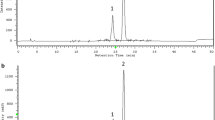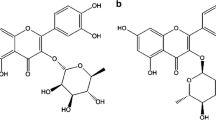Abstract
Animal experiments were performed to develop Salvia plebeia (Labiatae) as a medicinal herb with sedative and gastroprotective activities; the former activity was measured using a pentobarbital-induced assay and the latter activity was measured in two gastric lesion-induced assays (HCl/EtOH-induced and indomethacin/bethanechol-induced assays) in mice. The MeOH extract and its EtOAc fraction were effective, although the former was less active than the latter. Rosmarinic acid (RA) isolated from S. plebeia was active in the same method at 10 and 20 mg/kg (p.o.). HPLC quantification demonstrated that RA comprised the largest proportion (28.5% of the MeOH extract, 33.0% of EtOAc extract; 4.46% of dry weight) of S. plebeia. The contents of five other compounds were much less than that of RA, although the contents of the three glycosides, 6-hydroxyluteolin 7-O-glucoside (0.28% of dry weight), cynaroside (0.35%) and nepitrin (0.43%) were higher than those of the two aglycones, quercetin (0.024%) and eupatilin (0.058%). The HPLC method was validated in terms of linearity, precision, accuracy and reproducibility. These results suggest that the main polyphenol, RA, plays a major role in the sedative and gastroprotective effects of S. plebeia.
Similar content being viewed by others
References
Beer, D., Joubert, E., Malherbe, C. J., and Brand, D. J., Use of countercurrent chromatography during isolation of 6-hydroxyluteolin-7-O-β-glucoside, a major antioxidant of Athrixia phylicoides. J. Chromatogr. A, 1218, 6179–6186 (2011).
Behrman, S.W., Management of complicated peptic ulcer disease. Arch. Surg., 140, 201–208 (2005).
Chapado, L., Linares-Palomino, P. J., Salido, S., Altarejos, J., Rosado, J. A., and Salido, G. M., Synthesis and evaluation of the platelet antiaggregant properties of phenolic antioxidants structurally related to rosmarinic acid. Bioorg. Chem., 38, 108–114 (2010).
Coleta, M., Campos, M. G., Cotrim, M. D., Lima, T. C. M., and Cunha, A. P., Assessment of luteolin (3,4,5,7-tetrahydroxyflavone) neuropharmacological activity. Behav. Brain Res., 189, 75–82 (2008).
Demir, S., Yilmaz, M., Koseoglu, M., Akalin, N., Aslan, D., and Aydin, A., Role of free radicals in peptic ulcer and gastritis. Turk. J. Gastroenterol., 14, 39–43 (2003).
Ersoy, S., Orhan, I., Turan, N. N., Sahan, T. G., and Tosun, A. F., Endothelium-dependent induction of vasorelaxation by Melissa officinalis L. ssp. officinalis in rat isolated thoracic aorta. Phytomedicine, 15, 1087–1092 (2008).
Fernández, S., Wasowski, C., Paladini, A. C., and Marder, M., Sedative and sleep-enhancing properties of linarin, a flavonoid-isolated from Valeriana officinalis. Pharmacol. Biochem. Behav., 77, 399–404 (2004).
Harty, R.F., Ancha, H. R., Xia, Y., Anderson, M., and Jazzar, A., GABAergic mechanisms of gastroprotection in the rat: role of sensory neurons, prostaglandins, and nitric oxide. Dig. Dis. Sci., 49, 1875–1881 (2004).
Huang, N., Hauck, C., Yum, M. Y., Rizshisky, L., Widrlechner, M. P., McCoy, J. A., Murphy, P. A., Dixon, P. M., Nikolau, B. J., and Birt, D. F., Rosmarinicacid in Prunella vulgaris ethanol extract inhibits lipopolysaccharide-induced prostaglandin E2 and nitric oxide in RAW264.7 mouse macrophages. J. Agric. Food Chem., 25, 10579–10589 (2009).
Jäger, A.K., Krydsfeldt, K., and Rasmussen, H. B., Bioassay-guided isolation of apigenin with GABA-benzodiazepine activity from Tanacetum parthenium. Phytother. Res., 23, 1642–1644 (2009).
Jin, X., Lu, Y., Wei, D., and Wang, Z., Chemical fingerprint and quantitative analysis of Salvia plebeia R.Br. by highperformance liquid chromatography. J. Pharm. Biomed. Anal., 48, 100–104 (2008).
Johnston, G.A. R. and Beart, P. M., Flavonoids: some of the wisdom of sage? Brit. J. Pharmacol., 142, 809–810 (2004).
Kavvadias, D., Sand, P., Youdim, K. A., M. Qaiser, M. Z., Rice-Evans, C., Baur, R., Sigel, E., Rausch, W. D., Riederer, P., and Schreier, P., The flavone hispidulin, a benzodiazepine receptor ligand with positive allosteric properties, traverses the blood-brain barrier and exhibits anticonvulsive effects. Brit. J. Pharmacol., 142, 811–820 (2004).
Lee, G.T., Duan, C. H., Lee, J. N., Lee, K. S., Hong, J. T., and Lee, K. K., Phytochemical constituents from Salvia plebeia. Nat. Prod. Sci., 16, 207–210 (2010).
Lewis, D.A., Fields, W. N., and Shaw G. P., A natural flavonoid present in unripe plantain banana pulp (Musa sapientum L. var. paradisiaca) protects the gastric mucosa from aspirin-induced erosions. J. Ethnopharmacol., 65, 283–288 (1999).
Lu, Y. and Foo, L.Y., Polyphenolics of Salvia — a review. Phytochemistry, 59, 117–140 (2002).
Ly, T.N., Shimoyamada, M., and Yamaguchi, R., Isolation and characterization of rosmarinic acid oligomers in Celastrus hindsii Benth leaves and their antioxidative activity. J. Agric. Food Chem., 54, 3786–3793 (2006).
Melo, P.S., Duran, N. D., Hiruma-Lima, C. A., Souza-Brito, A. R. M., and Haun, M., Comparison of the gastroprotective effect of a diterpene lactone isolated from Croton cajucara with its synthetic derivatives. J. Ethnopharmacol., 87, 169–174 (2003).
Min, Y.S., Bai, K. L., Yim, S. H., Lee, Y. J., Song, H. J., Kim, J. H., Ham, I, Whang, W. K., and Sohn, U. D., The effect of luteolin-7-O-β-D-glucuronopyranoside on gastritis and esophagitis in rats. Arch. Pharm. Res., 29, 484–489 (2006).
Mizui, T. and Dodeuchi M., Effect of polyamines on acidified ethanol induced gastric lesion in rats. Jpn. J. Pharmacol., 33, 939–945 (1983).
Najim, R.A. and Saaed, K. K., Drugs acting at the GABAA receptor attenuate ethanol-induced gastric mucosal damage in vitro. Clin. Exp. Pharmacol. Physiol., 30, 495–500 (2003).
Nugroho, A., Choi, J., Lee, K., Bachri, M. S., Choi, J. S., Kim, W. B., Lee, K. T., and Park, H. J., Anti-ulcerogenic effect of the caffeoylquinicacid-rich extract from Ligulariastenocephala and HPLC analysis. Biol. Pharm. Bull., 33, 493–497 (2010).
Osakabe, N., Yasuda, A., Natsume, M., Sanbongi, C., Kato, Y., Osawa, T., and Yoshikawa, T., Rosmarinic acid, a major polyphenolic component of Perilla frutescens, reduces lipopolysaccharide (LPS)-induced liver injury in D-galactosamine (D-GalN)-sensitized mice. Free Radic. Biol. Med., 33, 798–806 (2002).
Sanbongi, C., Takanowz, H., Osakabe, N., Sasa, M., Natsume, M., Yanagisawa, R, Inoue, K., Sadakane, K., Ichinose, T., and Yoshikawa, T., Rosmarinic acid in perilla extract inhibits allergic inflammation induced bymite allergen in a mouse model. Clin. Exp. Allergy, 34, 971–977 (2004).
Song, H.J., Shin, C. Y., Oh, T. Y., and Sohn, U. D., The protective effect of eupatilin on indomethacin-induced cell damage in cultured feline ileal smooth muscle cells: involvement of HO-1 and ERK. J. Ethnopharmacol., 118, 94–101 (2008).
Yesilada, E. and Takaishi, Y., A saponin with anti-ulcerogenic effect from the flowers of Spartium junceum. Phytochemistry, 51, 903–908 (1999).
Yesilada, E., Gurbuz, I., Bedir, E., Tatli, I., and Khan, I. A., Isolation of anti-ulcerogenic sesquiterpene lactones from Centaurea solstitialis L. ssp. solstitialis through bioassayguided fractionation procedures in rats. J. Ethnopharmacol., 95, 213–219 (2004).
Yoo, Y.M., Nam, J. H., Kim, M. Y., Choi, J. W., Lee, K. T., and Park, H. J., Analgesic and anti-gastropathic effects of salidroside isolated from Acer tegimentosum Heartwood. The Open Bioact. Comp. J., 2, 28–34 (2009).
Yoshikawa, M., Murakami, T., Kishi, A., Kageura, T., and Matsuda, H., Medicinal flowers. III. Marigold. (1): hypoglycemic, gastric emptying inhibitory, and gastroprotective principles and new oleanane-type triterpene oligoglycosides, calendasaponins A, B, C, and D, from Egyptian Calendula officinalis. Chem. Pharm. Bull., 49, 863–870 (2001).
Author information
Authors and Affiliations
Corresponding author
Rights and permissions
About this article
Cite this article
Nugroho, A., Kim, MH., Choi, J. et al. In vivo sedative and gastroprotective activities of Salvia plebeia extract and its composition of polyphenols. Arch. Pharm. Res. 35, 1403–1411 (2012). https://doi.org/10.1007/s12272-012-0810-7
Received:
Revised:
Accepted:
Published:
Issue Date:
DOI: https://doi.org/10.1007/s12272-012-0810-7




